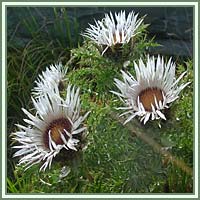CARLINE THISTLE
Carlina acaulis
Common name: Carline Thistle
Latin name: Carlina acaulis
Other names: Stemless Carline Thistle, Dwarf Carline Thistle, Silver Thistle
Family: Asteraceae
Habitat: Carline Thistle is native to alpine regions of central and southern Europe. The plant prefers chalky soils and dry pastures on high altitudes (up to 2800 m).
Description: Carline Thistle is a perennial plant. It has a thick rootstock, brown on the outside and light and fissured in the inside. The rootstock has a strong, aromatic odor when dried. The spiny, lanceolate leaves are radially arranged forming a basal rosette, approximately 20 cm in diameter. Flowers are produced in a large, stemless flowerhead with a creamy-white central disc, and silvery-white ray florets around it. Carline Thistle is in flower from August to September.
Parts used: Root
Useful components: Essential oil, inulin, tannins, palmitic acid, resins, flavonoids.
Medicinal use: Carline Thistle is considered to have anthelmintic, antiseptic, carminative, diaphoretic, digestive, diuretic, expectorant, febrifuge and tonic properties. Traditionally, the plant had been used in treatment of gastrointestinal and digestive disorders, different types of skin conditions, wounds, rashes and toothaches. A decoction of the root prepared with white wine or wine vinegar was used for washing wounds and for skin problems. Its present use is mostly external. The essential oil of Carline Thistle has been shown to have excellent antibacterial activity against Staphylococcus, Enterococcus, Salmonella and Shigella. Topical application of the root is said to remove scars.
Safety: Some herbs could react with certain medication. Therefore it is advisable to contact your doctor/herbalist before consumption of any herb.

